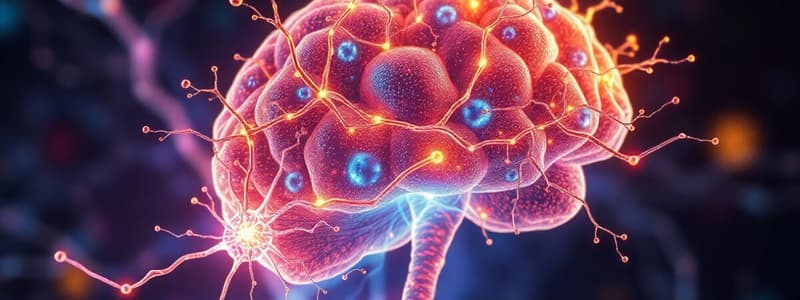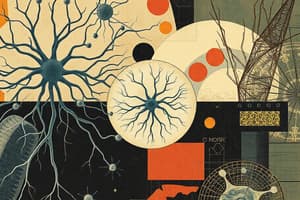Podcast
Questions and Answers
What is a characteristic of pseudo-unipolar neurons?
What is a characteristic of pseudo-unipolar neurons?
- They contain several spines for synaptic interactions.
- They possess a T-shaped process emerging from the cell body. (correct)
- They have multiple appendages for synaptic contacts.
- They are primarily located in the brain.
Which of the following describes a bipolarly structured neuron?
Which of the following describes a bipolarly structured neuron?
- It has one axon and several spines.
- It is elongated and does not connect to the spinal cord.
- It has both a dendrite and an axon. (correct)
- It contains a large number of Nissl granules.
Which type of neuron controls effector organs such as muscles and glands?
Which type of neuron controls effector organs such as muscles and glands?
- Sensory neurons.
- Interneurons.
- Pseudo-unipolar neurons.
- Motor neurons. (correct)
Golgi type I neurons are characterized by what feature?
Golgi type I neurons are characterized by what feature?
What is true regarding unmyelinated nerve fibers?
What is true regarding unmyelinated nerve fibers?
What type of neuron connects other neurons as seen in the retina and spinal cord?
What type of neuron connects other neurons as seen in the retina and spinal cord?
What distinguishes Golgi type II neurons from Golgi type I neurons?
What distinguishes Golgi type II neurons from Golgi type I neurons?
Which neurons are primarily found in the cochlear and vestibular ganglia?
Which neurons are primarily found in the cochlear and vestibular ganglia?
Which of the following statements about neuron cell bodies is true?
Which of the following statements about neuron cell bodies is true?
What characterizes the cytoplasm of a neuron cell body?
What characterizes the cytoplasm of a neuron cell body?
Which type of neuron has a cell body shape that is typically described as fusiform?
Which type of neuron has a cell body shape that is typically described as fusiform?
What feature differentiates dendrites from axons?
What feature differentiates dendrites from axons?
Which of the following is true regarding neuroglial cells?
Which of the following is true regarding neuroglial cells?
What is the primary function of microtubules in neuronal processes?
What is the primary function of microtubules in neuronal processes?
What is the significance of lipofuscin pigment in neurons?
What is the significance of lipofuscin pigment in neurons?
Which statement correctly describes the organization of neurofilaments in a neuron?
Which statement correctly describes the organization of neurofilaments in a neuron?
Which characteristic defines the structure of myelin sheath?
Which characteristic defines the structure of myelin sheath?
What role do nodes of Ranvier play in myelinated nerve fibers?
What role do nodes of Ranvier play in myelinated nerve fibers?
What does the endoneurium consist of in peripheral nerve organization?
What does the endoneurium consist of in peripheral nerve organization?
What is NOT a function of the Schwann cells?
What is NOT a function of the Schwann cells?
Which statement about myelinated nerve fibers is correct?
Which statement about myelinated nerve fibers is correct?
What type of nerve cell is characterized by a rounded cell body and a single divided process?
What type of nerve cell is characterized by a rounded cell body and a single divided process?
What is the primary function of the lipoproteins in the myelin sheath?
What is the primary function of the lipoproteins in the myelin sheath?
In the organization of peripheral nerves, what does perineurium do?
In the organization of peripheral nerves, what does perineurium do?
Flashcards
Cell Body (Perikaryon)
Cell Body (Perikaryon)
The central part of a neuron containing the nucleus and surrounding cytoplasm.
Neuron Size
Neuron Size
The cell body of a neuron can vary in size from 4 um to 100 um.
Neuron Shape
Neuron Shape
The cell body can have various shapes, depending on the specific type.
Neuron Nucleus
Neuron Nucleus
Signup and view all the flashcards
Nissl Bodies
Nissl Bodies
Signup and view all the flashcards
Golgi Complex
Golgi Complex
Signup and view all the flashcards
Mitochondria
Mitochondria
Signup and view all the flashcards
Neurofilaments
Neurofilaments
Signup and view all the flashcards
Pseudo-unipolar Neuron
Pseudo-unipolar Neuron
Signup and view all the flashcards
Bipolar Neuron
Bipolar Neuron
Signup and view all the flashcards
Multipolar Neuron
Multipolar Neuron
Signup and view all the flashcards
Sensory Neuron
Sensory Neuron
Signup and view all the flashcards
Motor Neuron
Motor Neuron
Signup and view all the flashcards
Interneuron
Interneuron
Signup and view all the flashcards
Golgi Type I Axon
Golgi Type I Axon
Signup and view all the flashcards
Golgi Type II Axon
Golgi Type II Axon
Signup and view all the flashcards
What is a nerve fiber?
What is a nerve fiber?
Signup and view all the flashcards
What are myelinated nerve fibers?
What are myelinated nerve fibers?
Signup and view all the flashcards
What are unmyelinated nerve fibers?
What are unmyelinated nerve fibers?
Signup and view all the flashcards
What is a Schwann cell?
What is a Schwann cell?
Signup and view all the flashcards
What are Nodes of Ranvier?
What are Nodes of Ranvier?
Signup and view all the flashcards
What are oligodendrocytes?
What are oligodendrocytes?
Signup and view all the flashcards
What is the epineurium?
What is the epineurium?
Signup and view all the flashcards
What is the perineurium?
What is the perineurium?
Signup and view all the flashcards
Study Notes
Nervous Tissue (Part 1)
- Nervous tissue is fundamental in the human body for communication.
- It includes neurons and neuroglial cells.
- Neurons are classified according to the number of processes and function.
- Neurons have a cell body (perikaryon), dendrites (multiple processes), and an axon (single process).
- The cell body is rounded in pseudo-unipolar neurons, fusiform in bipolar neurons, and stellate, pyramidal, or pyriform in multipolar neurons.
- Neuron size varies depending on location, ranging from 4 μm to 100 μm. For instance, granular cells in the cerebellar cortex are smaller than motor neurons.
- The cell body contains a large, euchromatic nucleus with a prominent nucleolus, characteristic of an active cell.
- The cytoplasm includes a well-developed rough endoplasmic reticulum (rER) and numerous polyribosomes. These structures, appearing as basophilic granular areas called Nissl bodies, are variable according to the neuronal function.
- Golgi complexes are centrally located around the nucleus.
- Mitochondria are dispersed throughout the cytoplasm.
- Neurofilaments (intermediate filaments) are prevalent in the perikaryon (cell bodies) and processes, visible through light microscopy (LM) stained with silver. These filaments provide structural support.
- Microtubules are arranged in parallel bundles within the perikaryon and processes, and are critical for axonal transport of neurotransmitter substances and enzymes.
- Centrioles are absent in neurons since neurons do not exhibit cell division.
- Inclusions present in neurons include lipofuscin pigment. It is a residue of undigested material from lysosomes, increasing with aging. Melanin, a dark brown or black pigment, is found in substantia nigra neurons and may be a byproduct of abnormal metabolism.
- Lipid droplets are found in the cytoplasm of neurons and represent stored energy.
Classification of Neurons
-
Pseudo-unipolar: The cell body is rounded, and the single process splits into peripheral and central branches shortly after leaving the perikaryon (cell body). The peripheral branch functions as a dendrite, and the central branch acts as an axon. Found in dorsal root ganglia & mesencephalic nucleus of the trigeminal nerve.
-
Bipolar: possess a single dendrite and single axon. Present in the cochlea and vestibular ganglia of the inner ear, and in the retina and olfactory mucosa.
-
Multipolar: have one axon and many dendrites. They appear as stellate (star-shaped) cells in the anterior horn of the spinal cord; pyramidal in the cerebral cortex; and pyriform in the cerebellar cortex (Purkinje cells).
Classifications of Neurons based on Function
- Sensory (Afferent): Receive sensory stimuli and transmit them to the spinal cord & brain via the dorsal root ganglion.
- Motor (Efferent): Transmit impulses from the central nervous system to muscles and glands, such as those in the anterior horn of the spinal cord.
- Interneurons: Connect neurons within the central nervous system. They are abundant in the brain and spinal cord and also in the retina.
Classification Based on Axon Length
- Golgi type I: neurons possess long axons extending beyond the grey matter into white matter. Examples include motor neurons in the spinal cord, pyramidal cells in the cerebral cortex, and Purkinje cells in the cerebellar cortex.
- Golgi type II: neurons possess short axons remaining confined within the grey matter. Examples include the vast majority of interneurons in the brain and cerebellum.
Nerve Fiber
- A nerve fiber is an axon (the projection of the neuron) surrounded by myelin and Schwann cells.
- The axon is encased by an axolemma, containing axoplasm, which is the cytoplasm within the axon.
- The axon emerges from the axon hillock, which is a conical extension from the cell body.
Types of Nerve Fibers
- Unmyelinated: Lack a myelin sheath and are subdivided into (a) naked fibers, present in gray matter; and (b) fibers with a Schwann cell sheath, prevalent in sympathetic postganglionic fibers.
- Myelinated: Possess a myelin sheath and are subdivided into (a) fibers without a Schwann cell sheath, found in white matter; and (b) fibers with a Schwann cell sheath, found in peripheral nerves.
The Schwann Cell Sheath
- The Schwann cell sheath consists of flattened cells with flattened nuclei that enwrap the myelin of the nerve fiber.
- Functions: Formation of the myelin sheath in the peripheral nervous system; insulation to speed up the nerve impulse; allowing for regeneration.
Myelin Sheath
- The myelin sheath is constructed from many modified cell membranes of Schwann cells.
- It possesses higher lipid content compared to cell membranes.
- Under the light microscope (LM), it appears as a dark structure stained by osmic acid.
- Under the electron microscope (EM), it's evident as fused spiral laminae of the plasmalemma.
- The myelin sheath is interrupted by Nodes of Ranvier, gaps between Schwann cells.
- The space between nodes are called inter-nodal segments.
Peripheral Nervous System
- Consists of nerves, ganglia (clusters of neuron cell bodies), and nerve endings.
- The components involved in the nervous system are also well organized into bundles that are structurally supported.
- Components of the bundles include, but are not limited to: epineurium, perineurium, and endoneurium.
Peripheral Nerve Structure
- The whole nerve is covered by a dense connective tissue sheath called the epineurium.
- Nerve fibers are organized into bundles, each surrounded by perineurium.
- The endoneurium, a connective tissue layer, surrounds individual nerve fibers.
Test Yourself Questions
- Question 1: Nerve fibers are the axon covered by the myelin and Schwann cells sheath.
- Question 2: Pseudo-unipolar neurons have rounded cell bodies and a single divided process.
Studying That Suits You
Use AI to generate personalized quizzes and flashcards to suit your learning preferences.




